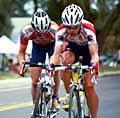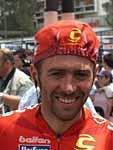
Recently on Cyclingnews.com |
Special report - December 4, 2002
Tainted Supplements: Positive or not? - Part I
By Jeff Jones
Contaminated supplements have been blamed for a number of positive drug tests in recent years, and the situation is not improving. Are supplements foods or drugs?
 |
US cyclist Scott Moninger's recent positive test for 19-norandrosterone has once again raised the issue of "tainted" sports supplements and positive drug tests. The majority of these positives have been for 19-norandrosterone, a metabolite of the anabolic steroid nandrolone. In the past few years, high profile athletes such as Spencer Smith, Dieter Baumann, Lindford Christie and Merlene Ottey have all tested positive for the drug, and all have been cleared.
In cycling, Scott Moninger is the latest in the long and non-exhaustive list of nandrolone positives that includes Benoît Joachim, Vassili Davidenko, Bjorn Cornelissen, Andreas Kappes, Duane Dickey, David McCann, Stefan Rütimann, Bert Roesems, Alvaro González de Galdeano, Jan Hruska, Fabiana Luperini, Philippe Gaumont, Jacky Durand, Thierry Laurent, Paola Pezzo, Laurent Desbiens, Serguei Outschakov and Lars Brian Nielsen.
Many of these riders have used the "tainted supplement" excuse in their defense, while others have used the time honoured "procedural irregularities" to get off the hook. In the former cases, there was no doubt that the norandrosterone was in the cyclists' bodies, and they generally finished up with a suspension. In the latter cases there was some doubt, and they were usually cleared.
The Olympic Movement and many national drug agencies now have a policy of 'strict liability', whereby the athlete is solely responsible for whatever substance that is found in their bodies. It doesn't matter if they took a banned substance inadvertently or not. The fact that it is there is enough for them to test positive, and thereby attract a suspension.
 |
One of the exceptions to this rule is the Italian cycling federation (FCI), which cleared Gilberto Simoni after he tested positive for cocaine on two separate occasions in April and May. Although there was no doubt about the positive test, it was shown that Simoni had inadvertently consumed cocaine in the form of Peruvian candies given to him by his aunt. The FCI's disciplinary committee accepted this explanation and he was cleared, and returned to racing in early August.
Then there is the case of German track rider Andreas Kappes, who tested positive for nandrolone in 2000. Kappes was able to use the contaminated food supplement argument to convince the German cycling federation (BDR) to acquit him, although it was reluctant to do so as he had already tested positive for a banned substance in 1997.
The Netherlands is an example of a country that does not have a firm policy on athlete liability. KNWU spokesman Gudo Kramer told Cyclingnews that "The anti-doping commission tries to judge every case by itself. If you take a look at past cases, there is a strong leaning towards personal liability of the rider, although we have known cases where the rider could prove that things happened without his knowledge, and the commission has used that to lighten the punishment."
This could be what happens to Scott Moninger, who says he can prove that he did not deliberately take nandrolone. The US cycling federation can sanction him for between 6 months and two years, but given the circumstances of the case it seems likely that he will end up with a 6 month ban.
The supplement contamination problem
Excerpt of the USA's 1994 Dietary Supplement Health Education Act (DSHEA)Excerpt of the USA's 1994 Dietary Supplement Health Education Act (DSHEA) Definition of Dietary Supplement FDA traditionally considered dietary supplements to be composed only of essential nutrients, such as vitamins, minerals, and proteins. The Nutrition Labeling and Education Act of 1990 added "herbs, or similar nutritional substances," to the term "dietary supplement." Through the DSHEA, Congress expanded the meaning of the term "dietary supplements" beyond essential nutrients to include such substances as ginseng, garlic, fish oils, psyllium, enzymes, glandulars, and mixtures of these. The DSHEA established a formal definition of "dietary supplement" using several criteria. A dietary supplement: *Is a product (other than tobacco) that is intended to supplement the diet that bears or contains one or more of the following dietary ingredients: a vitamin, a mineral, an herb or other botanical, an amino acid, a dietary substance for use by man to supplement the diet by increasing the total daily intake, or a concentrate, metabolite, constituent, extract, or combinations of these ingredients. *Is intended for ingestion in pill, capsule, tablet, or liquid form. *Is not represented for use as a conventional food or as the sole item of a meal or diet. *Is labeled as a "dietary supplement." *Includes products such as an approved new drug, certified antibiotic, or licensed biologic that was marketed as a dietary supplement or food before approval, certification, or license (unless the Secretary of Health and Human Services waives this provision). |
When the number of nandrolone positives suddenly shot up in the late 1990's, many people were surprised that athletes would take a banned substance that is so easily detectable. Being an anabolic steroid, nandrolone and its metabolites remain in the body for several months and can be detected at very low levels. It should be noted that nandrolone can naturally occur in the body in small amounts, so the IOC (2 ng/mL) and the UCI (5 ng/mL) have set minimum allowable limits for the drug before an athlete is declared positive.
Studies done on the spate of nandrolone positives were somewhat inconclusive. In 2000, a British review panel concluded that the risk of ingesting nandrolone via the "normal everyday consumption of food" was negligible. However, they did note that "athletes could be at risk if they consumed supplements which have little or no regulation of their contents."
When discussing 'regulation' and 'supplements' in the same sentence, it's worthwhile referring to the USA's Dietary Supplement Health and Education Act (DSHEA) of 1994. This controversial act, which was passed through Congress at a late night session, redefined what a dietary supplement was, in effect giving the supplement manufacturers a lot more freedom with regard to what they could put in their supplements. In cases of alleged unsafe supplements, it placed the burden of proof on the Food and Drug Administration (FDA) to prove that a product is unsafe before it could be removed from sale.
The lack of regulation in the supplement industry (and this is not restricted to the US) combined with the ease of obtaining supplements has meant that athletes are at greater risk than ever of inadvertently ingesting banned substances. So how risky is it?
In October 2000, the IOC commissioned a study on the prevalence of banned substances in nutritional supplements. More specifically, non-hormonal supplements were analysed for anabolic-androgenic steroids that were not listed on the label. The study was carried out by the IOC accredited doping laboratory in Cologne, Germany, between October 2000 and November 2001, and the results published in April 2002.
A total of 634 non-hormonal nutritional supplements from 13 countries and 215 different suppliers were tested in the study. The results showed that an incredible 94 samples (14.8%) found to contain unlisted substances that would lead to a positive doping test.
"Out of these 94 samples, 23 contained precursors (building blocks) of both nandrolone and testosterone, 64 contained precursors of testosterone alone and 7 contained precursors of nandrolone alone," the IOC's report said. Contamination levels ranged from 0.01 µg/g up to 190 µg/g. For the record, Scott Moninger claims his L-Tyrosine supplement was contaminated with 28mg of nandrolone per 500mg capsule. That's equivalent to 56,000 µg/g.
The Netherlands topped the list with the number of 'supplement positives', with 25.8 percent of the products tested containing a banned substance. Austria, UK, USA and Italy were the next on the list, with between 14.3 and 22.7 percent of the products tested being 'positive'. Put in an alternate way, if an athlete in the US buys a random selection of five nutritional supplements, then it's more than likely they will test positive in a drug control.
These rather disturbing statistics caused the IOC to reiterate its stance on nutritional supplements, which it had been warning athletes about since 1997. "The IOC hopes the results of this study demonstrate to governments and the industry the need for greater quality control to ensure substances not found on the label are not found in the product. The IOC Medical Commission recommends controls, similar to those pertaining to the manufacture of pharmaceuticals, be applied to the production of nutritional supplements."
Try getting that past the DSHEA!
There is also the impact on public health, given the harmful side effects of anabolic steroids on those who don't need them. "The fact that the public is unknowingly ingesting the precursors to hormones should be a matter of public health concern," the IOC report noted.
Food supplement test results
Country No. tested No.'positive' % 'positive' Netherlands 31 8 25.80% Austria 22 5 22.70% UK 37 7 18.90% USA 240 45 18.80% Italy 35 5 14.30% Spain 29 4 13.80% Germany 129 15 11.60% Belgium 30 2 6.70% France 30 2 6.70% Norway 30 1 3.30% Switzerland 13 - - Sweden 6 - - Hungary 2 - - Total 634 94 14.80% *'Positive' means number/% of supplements containing banned substances Source: IOC
